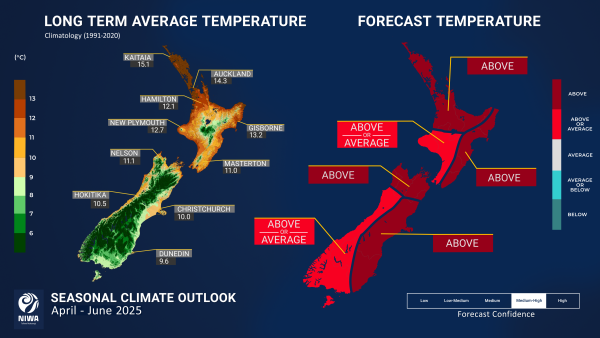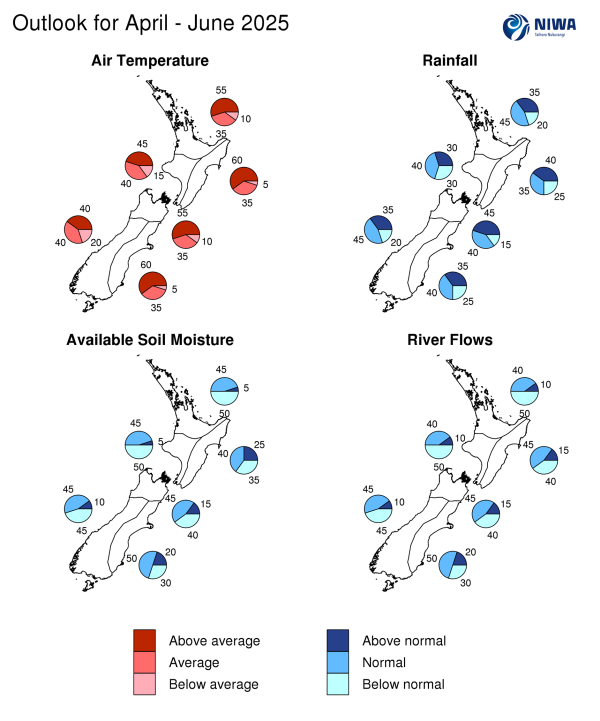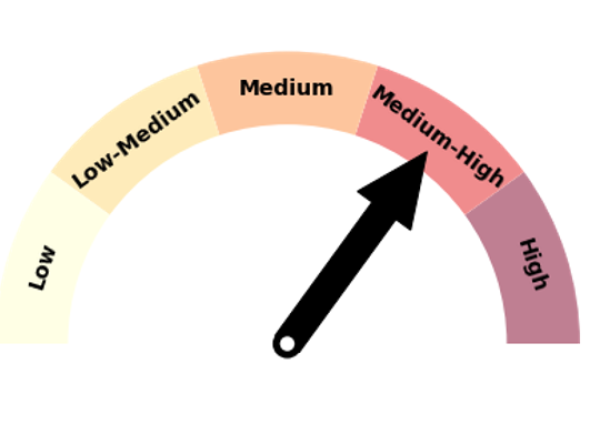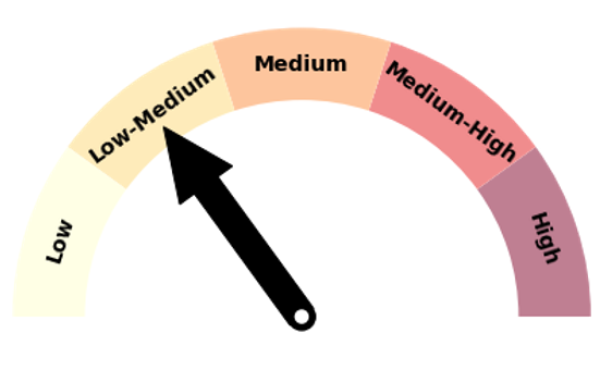Outlook summary
- In March 2025, the oceanic markers of La Niña weakened significantly, with most now falling within the ENSO-neutral range.
- The atmosphere, however, still exhibits signals consistent with La Niña conditions.
- International guidance indicates about an 85% chance for the tropical Pacific to fully transition to ENSO-neutral conditions over the April – June 2025 period.
- For New Zealand, higher than normal atmospheric pressure is expected to the southeast of the country, which is anticipated to result in overall northeasterly quarter flow anomalies.
- However, bouts of southwesterlies are expected.
- The threat for heavy rain events will be elevated when tropical or sub-tropical air flows occur, as expected in early April.
- For areas experiencing abnormally low soil moisture levels and river flows, regular and persistent rainfall is needed to reverse the effects of dryness and drought.
- Seasonal air temperatures are expected to be near average or above average for the west of both the North and South Islands, and above average for all other regions of the country.
- April – June rainfall totals, as a whole, are expected to be near normal for the north and west of the North Island and the west of the South Island. Near normal or above normal seasonal rainfall totals are expected for the north and east of the South Island, as well as the east of the North Island. Sub-seasonal projections of rainfall and dryness are updated daily through the NIWA35 forecast.
- The risk for an ex-tropical cyclone to pass within 550 km of New Zealand is normal-to-elevated through April.
- Ocean waters around the South Island remain warmer than average, with extended offshore areas still experiencing Marine Heat Wave conditions. Global climate forecasts indicate that above-average Sea Surface Temperatures (SSTs) are likely to persist, particularly around the South Island over the next three months.
- In April – June 2025 soil moisture levels and river flows most likely to be near normal in the east of the South Island. For the north and west of the North Island, soil moisture levels are about equally likely to be near or below normal, and river flows most likely to be below normal. Near or below normal soil moisture levels and river flows are expected for the remainder of the country.
Regional predictions for April – June 2025
The tables below show the probabilities (or percent chances) for each of three categories: above average, near average, and below average. In the absence of any forecast guidance there would be an equal likelihood (33% chance) of the outcome for any of the three categories. Forecast information from local and global guidance models is used to indicate the deviation from equal chance that is expected for the coming three-month period. All outlooks are for the three months as a whole. There will inevitably be relatively wet and dry days, and hot and cold days, within a season. The exact range in temperature and rainfall within each of the three categories varies with location and season. However, as a guide, the “near average” or middle category for the temperature predictions includes deviations up to ±0.5°C relative to the long-term mean, whereas for rainfall the “near normal” category lies between 80 percent and 120 percent of the long-term (1991-2020) mean.
Northland, Auckland, Waikato, Bay of Plenty
- Temperatures are most likely to be above average (55% chance).
- Rainfall totals are most likely to be near normal (45% chance) for April – June 2025 as a whole. Heavy rain events are possible on occasion.
- Soil moisture levels are about equally likely to be below normal (50% chance) or near normal (45% chance).
- River flows are most likely (50% chance) to be below normal.
| Temperature | Rainfall | Soil moisture | River flows | |
| Above average | 55 | 35 | 5 | 10 |
| Near average | 35 | 45 | 45 | 40 |
| Below average | 10 | 20 | 50 | 50 |
Central North Island, Taranaki, Whanganui, Manawatu, Wellington
Probabilities are assigned in three categories: above average, near average, and below average.
- Temperatures are about equally likely to be above average (45% chance) or near average (40% chance).
- Rainfall totals are most likely to be near normal (40% chance).
- Soil moisture levels are about equally likely to be below normal (50% chance) or near normal (45% chance).
- River flows are most likely (50% chance) to be below normal.
| Temperature | Rainfall | Soil moisture | River flows | |
| Above average | 45 | 30 | 5 | 10 |
| Near average | 40 | 40 | 45 | 40 |
| Below average | 15 | 30 | 50 | 50 |
Gisborne, Hawke’s Bay, Wairarapa
Probabilities are assigned in three categories: above average, near average, and below average.
- Temperatures are very likely to be above average (60% chance).
- Rainfall totals are about equally likely to be above normal (40% chance) or near normal (35% chance).
- Soil moisture levels and river flows are both about equally likely to be near normal (40% to 45% chance) or below normal (35% to 40% chance).
| Temperature | Rainfall | Soil moisture | River flows | |
| Above average | 60 | 40 | 25 | 15 |
| Near average | 35 | 35 | 40 | 45 |
| Below average | 05 | 25 | 35 | 40 |
Tasman, Nelson, Marlborough, Buller
Probabilities are assigned in three categories: above average, near average, and below average.
- Temperatures are most likely to be above average (55% chance).
- Rainfall totals are about equally likely to be above normal (45% chance) or near normal (40% chance). A significant rainfall event is anticipated early in April.
- Soil moisture levels and river flows are both about equally likely to be near normal (45% chance) or below normal (40% chance).
| Temperature | Rainfall | Soil moisture | River flows | |
| Above average | 55 | 45 | 15 | 15 |
| Near average | 35 | 40 | 45 | 45 |
| Below average | 10 | 15 | 40 | 40 |
West Coast, Southern Alps and foothills, inland Otago, Southland
Probabilities are assigned in three categories: above average, near average, and below average.
- Temperatures are equally likely to be above average (40% chance) or near average (40% chance).
- Rainfall totals are most likely to be near normal (45% chance). However, a significant rainfall event is anticipated early in April.
- Soil moisture levels and river flows are equally likely to be below normal (45% chance) or near normal (45% chance).
| Temperature | Rainfall | Soil moisture | River flows | |
| Above average | 40 | 35 | 10 | 10 |
| Near average | 40 | 45 | 45 | 45 |
| Below average | 20 | 20 | 45 | 45 |
Coastal Canterbury and the nearby plains, east Otago
Probabilities are assigned in three categories: above average, near average, and below average.
- Temperatures are very likely to be above average (60% chance).
- Rainfall totals are about equally likely to be near normal (40% chance) or above normal (35% chance).
- Soil moisture levels and river flows are most likely to be near normal (50% chance).
The full probability breakdown is:
| Temperature | Rainfall | Soil moisture | River flows | |
| Above average | 60 | 35 | 20 | 20 |
| Near average | 35 | 40 | 50 | 50 |
| Below average | 05 | 25 | 30 | 30 |
Background
Sea surface temperature (SST) anomalies in the central equatorial Pacific (Niño 3.4 region) during March (values estimated using data to 29 March) were close to zero (+0.08˚C). SSTs currently remain slightly below average in the central Pacific (Niño 4 region, with a value of -0.3˚C), but all Niño indices have warmed over the past three months, and positive SST anomalies off the South American coast have intensified and extended westward to about 130oW, which could potentially be classified as a “coastal El Niño” if these conditions persist. The Relative Niño 3.4 Index (RONI) for the 30 days leading up to 29 March was -0.39˚C, indicating conditions on the La Niña side of neutral.
Despite the oceanic changes, atmospheric indicators still reflect La Niña-like conditions: the Southern Oscillation Index (SOI) value for March 2025 (preliminary value estimated using data to 29 March) was +1, trade winds were stronger than normal during most of March over and west of the International Date Line, and convection and rainfall remained suppressed in the central Pacific and enhanced in the western Pacific, consistent with La Niña conditions.
During March 2025, upper-oceanic heat content (temperature anomalies in the upper 300 m of the ocean) was above average in the far western tropical Pacific. Anomalies exceeding +2oC remain present south of the Equator from the Maritime Continent to the International Date Line. Negative anomalies are present east of the International Date Line in the central and eastern Pacific, reaching -2oC in places, but these decreased compared to last month due to developing warm surface temperatures in the far eastern Pacific.
The subsurface equatorial Pacific remained warmer than normal in the West Pacific Warm Pool region especially between 50 m and 150 m depth, with values exceeding +3oC at about 150 m depth. East of the International Date Line, cooler than normal ocean waters are still present between about 50 m and 100 m depth, but these anomalies have weakened compared to last month and are capped by warmer than normal waters east of about 130oW.
Based on the dynamical and statistical models monitored by NIWA, a transition to ENSO-neutral conditions is very likely (about an 85% chance) over the next three-month period. While long-range ENSO forecasts tend to be less reliable as one enters the autumn season (the so-called “ENSO predictability barrier”), the guidance available suggests the possibility for La Niña conditions to return by summer 2025 – 2026 (i.e. a ‘double-dip’ La Niña).
The Southern Annular Mode (SAM) was positive overall during the month of March (82% of days positive) and the monthly average anomaly (estimated using daily data to 28 March) was +0.74 std. The GEFS forecast is for the SAM to remain positive over the next two weeks.
The Indian Ocean Dipole (IOD) index was also in the neutral range in March 2025, with the average anomaly for the month (estimated using data to 29 March) being +0.24oC. The IOD is expected to remain neutral over the forecast period.
During March 2025, convective forcing associated with the MJO propagated into the Maritime Continent and the western Pacific (phases 5-6) and was associated with enhanced convection over the same region, and linked to strengthened trade winds just west of the International Date Line. This MJO signal temporarily reinforced the La Niña-like atmospheric conditions that were generally present in March. The future intensity of this MJO pulse is uncertain as it moves eastward.
Ocean waters remained warmer than normal in March 2025, especially around the South Island, and Marine Heat Wave conditions (at least five consecutive days above the 90th percentile) were present over extended areas offshore of the west and east coasts of the South Island. Model guidance generally suggests that above average ocean temperatures are likely to persist especially around the South Island over the April – June 2025 period.
The Relative Oceanic Niño 3.4 Index (RONI) is a modern way of measuring oceanic El Niño and La Niña that is complementary to oceanic traditional indices. While traditional oceanic indices like the Niño 3.4 Index monitor SSTs in one region, the RONI compares the average SST in the central equatorial Pacific with the average SST across the global tropics. Since tropical rainfall patterns respond to changes in ocean temperatures, this new relative index can help forecasters better determine if the equatorial Pacific is warmer or cooler than the rest of the global tropics, which has become more challenging to discern as seas warm because of climate change.
| North NI | +0.72°C |
| West NI | +0.84°C |
| East NI | +0.87°C |
| North SI | +0.94°C |
| West SI | +1.06°C |
| East SI | +1.50°C |
Forecast Confidence
Temperature
Forecast confidence for temperatures is medium-high. There is a large degree of agreement between the General Circulation Models’ forecasts that NIWA leverages for its Seasonal Climate Outlook.








